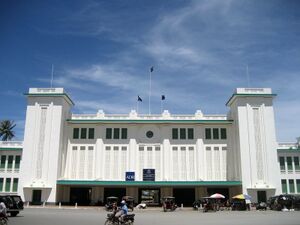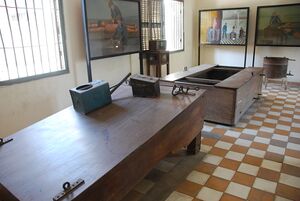Phnom Penh
| Phnom Penh | |||||
|---|---|---|---|---|---|
| Japanese Name | プノンペン | ||||
| Weapon | |||||
| Race | Human | ||||
| Nationality | |||||
| Birthday | October 5 | ||||
| Constellation | Libra | ||||
| Talents | Diving, First aid | ||||
| Likes | Lack of oxygen, Underwater Scenery, Smiles | ||||
| Dislikes | Floods, People that look down on others' interests | ||||
| Strengths | Able to take accurate measures without panicking in times of crisis | ||||
| Weaknesses | Trying to pull people underwater | ||||
| Hobbies | Running out of oxygen | ||||
You see, I used to be the top of my class back home. I can study, I can do housework, and I can fight just fine. Perfect partner to die together with, don't you think?
Layers
| Icon | Title | Release Date | Where to Obtain |
|---|---|---|---|
| [Deep Sea Dreamer] Phnom Penh | 2021 August 30 (EN) | Premium Gacha | |
| [Underwater New Year Greeting] Phnom Penh | 2022 January 1 (EN) | [It's Time~! Chichi's New Year~] Limited Gacha | |
| [Let's Drown in the Chocolate Sea‽] Phnom Penh | 2022 January 31 | [Beast Frozen Chocolate] Limited Gacha | |
| [Underwater Heaven] Phnom Penh | 2021 September 6 (EN) | [Abashiri Prison] Pick Up Gacha, Premium Gacha | |
| [To the Bottom of Darkest Waters] Phnom Penh | 2022 September 30 | 2nd Anniversary Limited Gacha 3 |
Obtained Skills
Trivia
- Phnom Penh's birthday is the Pchum Ben holiday, a Cambodian 15-day religious festival, culminating in celebrations on the 15th day of the tenth month in the Khmer calendar, at the end of the Buddhist Lent, Vassa. This holiday usually begins in October 5 annually (2015 season began on 23 September).
- Phnom Penh's asphyxiation via drowning motif, as well as her spear's skeleton design (death), is a reference to the Tuol Sleng Genocide Museum. Waterboarding tortures are common to force out confessions from prisoners during the Khmer Rouge era.
- Phnom Penh's "horn decorations" on her hair are derived from the roof decorations of the Royal Palace of Cambodia (ព្រះបរមរាជវាំង).
- Phnom Penh's ironic dislike of floods is a reference to the serious flooding problems to the city of Phnom Penh, caused by runoff from the Mekong River and heavy rains in Cambodia, especially around the Tonle Sap Lake.
- The sunken building in the background of [To the Bottom of Darkest Waters] is the Angkor Wat, a temple complex in Cambodia and is the largest religious monument in the world, on a site measuring 162.6 hectares.
Counterpart
Phnom Penh Royal railway station (រាជាយស្ម័យានកម្ពុជា) is a railway station in Phnom Penh, Cambodia. It is located next to the University of Health Sciences and the National University of Management as well as the Canadian embassy. The station was built in 1932 from reinforced concrete to service the railway to Battambang. This station was renovated and formally reopened October 22, 2010. Scheduled passenger train services between Phnom Penh and Sihanoukville resumed in May 2016 after having been suspended for 14 years.
The French colonial government built the first line, running from Phnom Penh to Poipet on the Thai border, between 1930 and 1940, with Phnom Penh Railway Station opening in 1932. The final connection with Thailand was completed by Royal State Railways in 1942. However, the service from Bangkok to Battambang was suspended when the French Indochinese Government resumed sovereignty over Battambang and the Sisophon area from Thailand on 17 December 1946, as Thailand was seen as a supporter of Khmer Issarak, the anti-French, Khmer nationalist political movement.
Cambodia has 612 km (380 mi) of 1000 mm metre gauge rail network, consisting of two lines: one from the capital Phnom Penh to Sihanoukville, and another from Phnom Penh to Poipet on the Thai border. The lines were originally constructed during the time when the country was part of French Indochina, but due to neglect and damage from civil war during the latter half of the 20th century, the railways were in a dilapidated state and all services had been suspended by 2009. Through rehabilitation efforts by the Government of Cambodia, with funding from the Asian Development Bank, Australian Agency for International Development (AusAID) and Australian company Toll Holdings, freight and limited passenger service returned between Phnom Penh and Sihanoukville by 2016, and passenger service between Phnom Penh and Poipet was fully restored in 2019. Wikipedia
The Tuol Sleng Genocide Museum (សារមន្ទីរឧក្រិដ្ឋកម្មប្រល័យពូជសាសន៍ទួលស្លែង) or simply Tuol Sleng (ទួលស្លែង; lit. "Hill of the Poisonous Trees" or "Strychnine Hill") is a museum chronicling the Cambodian genocide. Located in Phnom Penh, the site is a former secondary school which was used as Security Prison 21 (មន្ទីរស-២១) by the Khmer Rouge regime from 1975 until its fall in 1979. From 1976 to 1979, an estimated 20000 people were imprisoned at Tuol Sleng and it was one of between 150 and 196 torture and execution centers established by the Khmer Rouge.
The buildings at Tuol Sleng are preserved, some rooms as they were left when the Khmer Rouge were driven out in 1979. The regime kept extensive records, including thousands of photographs. Several rooms of the museum are now lined, floor to ceiling, with black and white photographs of some of the estimated 20000 prisoners who passed through the prison. The site has four main buildings, known as Building A, B, C, and D. Building A holds the large cells in which the bodies of the last victims were discovered. Building B holds galleries of photographs. Building C holds the rooms sub-divided into small cells for prisoners. Building D holds other memorabilia including instruments of torture.
On 26 July 2010, the Extraordinary Chambers in the Courts of Cambodia convicted the prison's chief, Kang Kek Iew, for crimes against humanity and grave breaches of the 1949 Geneva Conventions. He died on 2 September 2020 while serving a life sentence. Wikipedia
Map
Gallery
- Pages using Tabber parser tag
- Pages using DynamicPageList3 parser tag
- Weapon Spear
- Human
- Flamarine
- Libra
- Element Pierce
- Element Dark
- Element Water
- Element Light
- Train Knights
- Cambodia


















